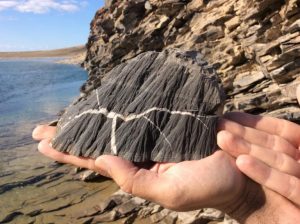
Though we often associate impact events as destructive, recent investigations have suggested that the residual heat produced by the impact can create potential habitats for life. This is believed to be possible based on evidence of hydrothermal activity post impact. Hydrothermal activity simply refers to the movement of heated water, usually beneath the surface of the earth. We often see these systems near volcanic magma chambers where heat from the chamber causes the circulation of hot water. Within impact structures, hydrothermal systems depend on temperature gradients remaining in shocked rocks. In dry geologic environments, such as the Moon, the heat loss occurs mainly by conduction (heat transferred by the touching materials) and radiation (emission of energy through electromagnetic waves or as moving subatomic particles), but when water is present convective heat transfer takes place.

Hydrothermal activity was first recognized at impact structures through the different alterations to the target rocks. To date, hydrothermal alteration has been found at more than 60 terrestrial craters mainly as the presence of clays, zeolites, carbonates, and sulphate mineral phases. Fluid inclusions, small pockets of gas and liquid within rocks, have also been found at impact structures are frequently used to understand the geologic history of hydrothermal systems. From remote sensing missions to Mars, mineral phases associated with hydrothermal activity have also been identified from orbit suggesting a similar process may be occurring in the Martian subsurface during impact events. The lifetime of these hydrothermal systems is dependent on the size of the cratering event. It is thought that large impact structures on Earth such as Chicxulub and Sudbury lasted for a few million years.
Given that these hydrothermal systems have a significant lifetime, are heated, and move large amounts of water, they have been proposed as potential habitats for early life on planetary bodies. By examining oceanic vents called “black smokers”, we know that life can flourish in the dark depths of the ocean. Organisms called lithotrophs, a group of organisms that use an inorganic substrate to sustain itself, have also been discovered to live in extreme environments by being “rock-eaters”. It is, therefore, possible that impact craters, though the product of a destructive collision, could also be possible habitat for life to develop and in recent years become of great interest to planetary scientists.